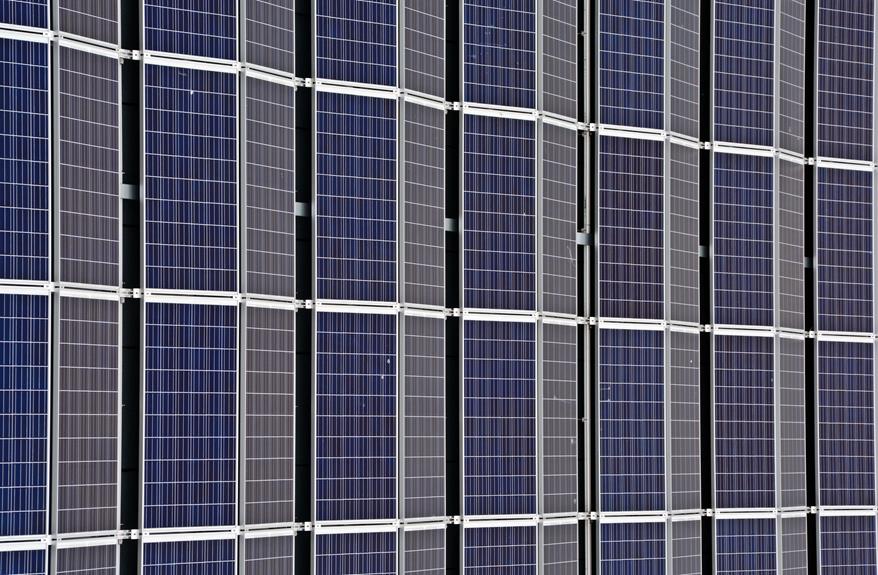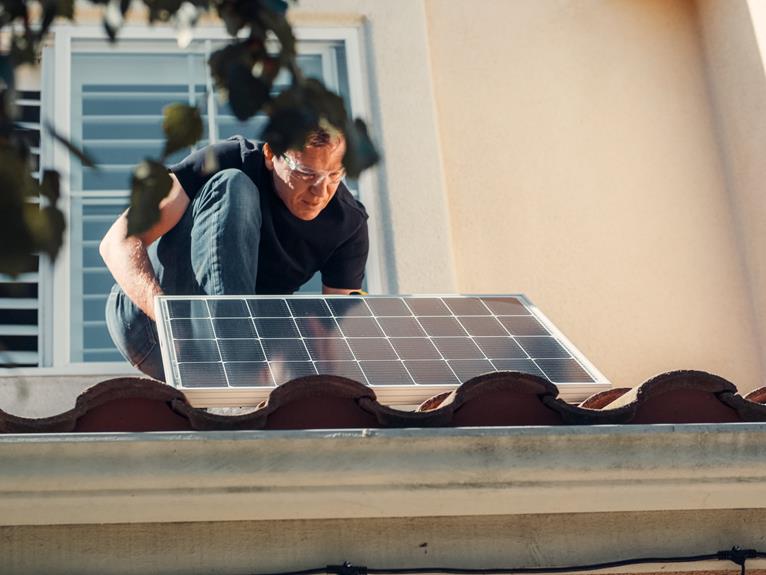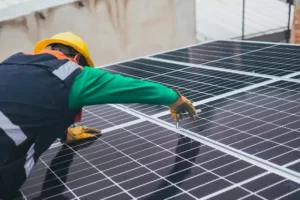As the sun sits high in the sky, a tireless beacon of energy, it’s easy to forget that you’ve harnessed a slice of this boundless power to cool your home or workspace with solar air conditioning.
You’ve leapt renewable energy, but to ensure that your system continues to run as smoothly as the summer breeze, it’s crucial to dive into the nuts and bolts of maintenance.
In this guide, you’ll learn the essentials of keeping your solar air conditioning system in tip-top shape, from the importance of regular inspections to the intricacies of filter replacement.
You’ll discover how to keep your panels spotless and your energy bills low, all while contributing to a greener planet.
And just when you think you’ve got it all figured out, we’ll introduce you to advanced tips that even seasoned solar aficionados might not know—techniques that can significantly extend life and enhance the performance of your investment.
So, don’t let your system’s potential cool off—stay tuned to uncover the secrets of solar air conditioning maintenance that will keep your space, and your conscience, comfortably cool.
Key Takeaways
- Regular system inspections and maintenance are essential for the early detection of issues and for ensuring optimal performance and energy output.
- Cleaning solar panels regularly helps maintain their efficiency by removing debris and avoiding the use of harsh chemicals and abrasive cleaning tools.
- Managing obstructions such as shade from trees or other structures is important to ensure uninterrupted sunlight exposure to the panels.
- Regularly replacing air filters and scheduling professional maintenance every few years are crucial for maintaining the air quality, system efficiency, and overall longevity of the solar air conditioning system.
Summary Of Complete Maintenance Guide for Solar Air Conditioning In Australia
| Component | Maintenance Task | Frequency | Procedure |
|---|---|---|---|
| Solar Panels | Clean panels from dirt, dust, and debris | Quarterly | 1. Turn off the solar AC system. 2. Gently brush off loose dirt. 3. Use a soft cloth or sponge with soapy water to clean the panels. 4. Rinse thoroughly with clean water. 5. Allow panels to dry. |
| Condenser Unit | Inspect for debris and clean as necessary | Semi-annually | 1. Turn off the solar AC system. 2. Remove debris around the unit. 3. Clean the condenser fins with a soft brush or compressed air. 4. Ensure proper airflow around the unit. |
| Refrigerant Levels | Check and adjust refrigerant levels if needed | Annually | 1. Schedule a professional HVAC technician. 2. Conduct a thorough inspection of the refrigerant levels. 3. Add refrigerant if necessary. |
| Ductwork | Inspect for leaks and seal if required | Annually | 1. Check for visible leaks in the ductwork. 2. Seal any leaks using appropriate duct sealant. |
| Fans and Blowers | Check for proper operation and clean blades | Semi-annually | 1. Turn off the solar AC system. 2. Inspect fan blades for dirt and debris. 3. Clean blades with a soft brush or cloth. 4. Ensure fans are properly balanced. |
| Electrical Components | Inspect wiring, connections, and tighten if necessary | Annually | 1. Turn off the solar AC system. 2. Inspect wiring and connections for signs of wear or damage. 3. Tighten loose connections. |
| Thermostat | Calibrate and test for accuracy | Annually | 1. Check thermostat readings against a calibrated thermometer. 2. Calibrate if necessary. 3. Test all thermostat functions. |
| Filters | Replace or clean air filters | Monthly or as needed | 1. Turn off the solar AC system. 2. Remove and clean or replace air filters. 3. Use manufacturer-recommended filters. |
| Drainage System | Inspect and clear the condensate drain | Quarterly | 1. Turn off the solar AC system. 2. Inspect the condensate drain for clogs or blockages. 3. Clear the drain using a vacuum or a pipe cleaner. |
| Overall System Check | Comprehensive inspection of the entire system | Bi-annually | 1. Schedule a professional HVAC technician. 2. Conduct a thorough inspection of all components. 3. Address any issues or potential problems identified during the inspection. |
This table serves as a general guide, and it is crucial to refer to the specific maintenance recommendations provided by the solar air conditioning system manufacturer. Regular professional maintenance is also highly recommended for optimal performance and longevity of the system.
Regular System Inspections
To keep your solar air conditioning system running smoothly, it’s crucial to schedule regular inspections for early detection of any potential issues. These routine checks are the backbone of system optimization, ensuring that you’re getting the best performance and longevity out of your investment.
Like a well-oiled machine, your solar air conditioning system requires a keen eye to monitor its performance and energy output, spotting problems before they escalate.
Don’t underestimate the importance of cleanliness; debris and dirt are the nemeses of efficiency. Make sure to keep your system free from such unwanted guests. It’s not just about a quick look-over. You need to dive deep into the health of your system components, maintaining them vigilantly to stave off any potential issues.
Every few years, it’s wise to bring in a professional solar installer for a thorough maintenance check. They’ll have the expertise to ensure that every part of your solar air conditioning system is in tip-top shape, safeguarding your comfort and your wallet.

Solar Panel Cleaning
While you’re keeping up with regular system inspections, don’t overlook the importance of solar panel cleaning to maintain your unit’s efficiency. Debris like leaves, dust, and bird droppings can hinder the absorption of sunlight, leading to a drop in energy output. This is where the significance of regular maintenance comes into sharp focus.
Cleaning techniques can range from a simple hose down to more thorough methods. For a basic clean, you can gently rinse the panels with water to remove loose debris. If they’re particularly dirty, use a soft brush or a squeegee attached to a long handle, along with soapy water, to scrub the surface without scratching it. Always avoid harsh chemicals and abrasive cleaning tools, as they can damage the panels.
It’s also wise to monitor your system’s performance before and after cleaning. A noticeable increase in efficiency indicates that the cleaning was successful. However, for peace of mind and the longevity of your system, consider using professional maintenance every few years. Professionals have the expertise and the right tools to ensure that your solar panels are in top condition, safeguarding your investment in solar air conditioning.

Obstruction Management
Have you considered how surrounding trees or structures might be shading your solar panels and reducing their efficiency? It’s essential to regularly check for any obstructions that may block the sun’s rays. Overhanging branches or burgeoning foliage can create shadows that impact your solar air conditioning system’s performance during those crucial peak sunlight hours.
To tackle this, you’ll need to master some trimming techniques. It’s not just about hacking away at branches; careful pruning can ensure that your trees stay healthy while letting that much-needed sunlight through. But before you start, it’s wise to perform a detailed shade analysis. This will help you identify the specific times of day and angles at which shadows fall on your panels, so you can trim with precision.
Don’t forget to keep the panels themselves free from debris like leaves, dirt, or bird droppings. These can also hinder the effectiveness of your system. And keep an eye out for any structural obstructions, such as new buildings or renovations, that could unexpectedly cast shade on your setup.
If you’re unsure about how to manage these obstructions, it’s always best to consult with a professional. They can assess your situation and provide expert advice to keep your solar air conditioning system running smoothly.

Filter Replacement Routine
Ensuring your solar air conditioning system operates at peak performance requires regularly replacing the air filters, typically every 1-3 months, to prevent airflow blockages and maintain indoor air quality. The filter lifespan can be influenced by various factors, including usage and environmental conditions. To maximize the efficiency of your system, it’s crucial to adhere to a strict filter replacement routine:
- Replace air filters every 1-3 months
- During high usage: Check filters monthly, especially in dusty conditions
- In milder climates: Replacement may extend toward the 3-month mark
Using high-quality filters is also important for optimal performance:
- Use high-quality filters
- Better air quality: High-quality filters capture more pollutants
- Increased system efficiency: Ensures smoother airflow and reduces strain on the system
Proper filter installation is paramount to ensure that the new filters function as intended. Here are a few tips to ensure you’re doing it right:
- Always turn off the system before replacement
- Check the filter size and ratings to match your specific unit
- Ensure the filter is fitted securely in place, with no gaps around the edges
Professional Maintenance Scheduling
Beyond keeping filters fresh, it’s crucial to schedule professional maintenance to tackle deeper system needs that ensure your solar air conditioning runs smoothly for years.
While you’re taking care of the basics, like regular cleaning to remove debris and monitoring system performance, there’s more to the health of your unit than meets the eye.
Professional maintenance should be seen as a preventive measure, not a last resort. Scheduling a check-up every few years with a certified solar installer can save you a significant amount in maintenance costs over the lifespan of your system. These experts delve into the technicalities that you might miss, from ensuring the solar panels are at peak efficiency to checking the integrity of all the connections.
Consulting with a professional isn’t just about fixing problems—it’s about avoiding them. They can fine-tune your system for optimal performance, which in turn secures its longevity. This is an investment in the future of your home’s sustainability and your comfort.
Surprising Facts About Maintenance Guide for Solar Air Conditioning
- 🌞 Solar air conditioning systems often use absorption or adsorption cooling technologies, which utilize heat energy from the sun to drive the cooling process, making them more energy-efficient than traditional systems.
- 🌐 Maintenance for solar air conditioning involves regularly checking and cleaning the solar collectors, as dust and debris can reduce their efficiency and impact the overall performance of the system.
- ⚙️ Some solar air conditioning systems incorporate a thermal energy storage component, allowing excess energy generated during sunny periods to be stored for later use during cloudy days or nighttime.
- 🏡 Integrating shade structures, such as pergolas or awnings, with solar panels can enhance the efficiency of solar air conditioning systems by providing a cooler environment for the panels and improving their overall performance.
- 🔄 Regularly inspecting and lubricating the moving parts of solar air conditioning systems, such as fans and pumps, is crucial for ensuring smooth operation and extending the lifespan of the equipment.
- 🌿 Solar air conditioning can contribute to sustainable living by reducing dependence on grid electricity, lowering carbon emissions, and promoting the use of clean energy sources.
- 💡 Some advanced solar air conditioning models feature smart technology that allows users to monitor and control the system remotely through mobile apps, providing increased convenience and energy management.
- 🔄 To optimize the efficiency of solar collectors, it’s important to adjust their tilt angles seasonally, ensuring they capture maximum sunlight throughout the year.
- 🌎 Maintenance should include checking the refrigerant levels in solar air conditioning systems, as inadequate levels can lead to reduced cooling capacity and decreased overall performance.
- 🌐 Collaborative initiatives and research are ongoing to develop innovative materials for solar air conditioning components, aiming to enhance durability, efficiency, and affordability in the long run.
Frequently Asked Questions
Can You Harness the Power of the Sun?
You can harness the sun’s power! By investing in solar efficiency, you’ll mitigate climate impact while enjoying sustainable energy. It’s a smart choice for both your wallet and the planet.
What Are the Disadvantages of Solar Air Conditioners?
You’ll find solar air conditioners have high initial costs and their performance hinges on the weather, which can be unpredictable. They’re an investment with both sunny prospects and potential cloudy drawbacks.
How Much Solar Power Is Needed to Run an Air Conditioner?
You’ll need to gauge your system’s sizing carefully; a 2-ton AC typically requires 2-4 kilowatts, while larger units demand more. Always factor in your local sun conditions for accurate energy requirements.
Can I Run My AC All Day With Solar?
Yes, you can run your AC all day with solar if the system sizing is correct. Energy efficiency hinges on proper installation and usage, ensuring your comfort without tapping into the grid.
Conclusion
In conclusion, maintaining your solar air conditioning system is crucial for optimal performance, energy efficiency, and longevity. Regular inspections, cleaning the solar panels, managing obstructions, replacing air filters, and scheduling professional maintenance are all essential tasks to keep your system running smoothly.
By following these maintenance practices, you can enjoy the benefits of a greener planet, lower energy bills, and comfortably cool space.
Remember, investing in the future of your solar air conditioning system is an investment in sustainability and your comfort. So stay proactive and keep your system in tip-top shape!



